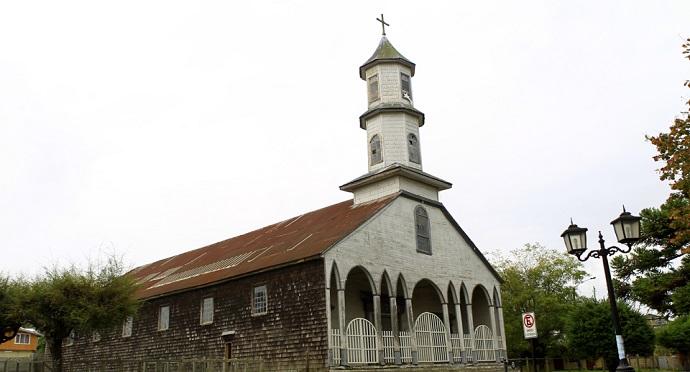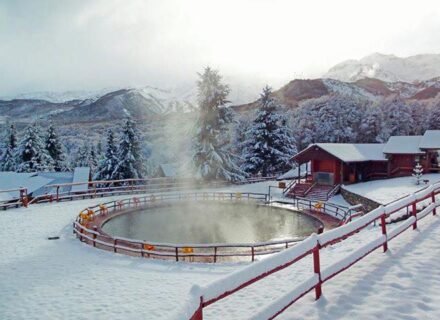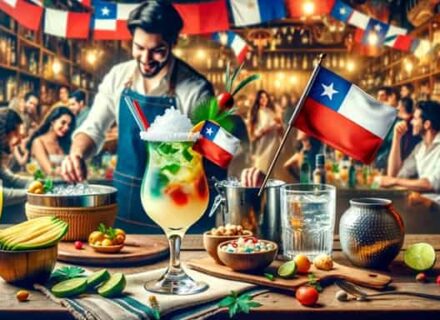Besides its flora and fauna, the southern archipelago of Chiloé preserves beautiful wooden churches built in the 18th century, 16 of which have been listed as World Heritage Sites by the UNESCO.
The Chiloé Archipelago, located 1.100 km south of Chile’s capital, it’s not only famous around the world for its magic, charm and varied myths and legends. Its islands have become part of the itineraries of both Chilean and foreign tourists due to their particular and unique wooden churches built in the 18th century. 16 of this historical and architectural wonders were recognized by the UNESCO as World Heritage Sites in 2001.
The origins of these catholic temples goes back to the arrival of the first Jesuits in Chile in 1608. With the aim of evangelizing the indigenous peoples of the area (huilliches, mainly), the representatives of this order wandered around the archipelago and stayed for days or weeks on particular places. Motivated by the celebration of religious festivities and with the aim of welcoming Christian groups, the community of believers set out to build the now famous churches.
The archipelago has more than 60 churches from what is now known as the Chiloé School of Wooden Religious Architecture. Its constructions stand out for having used native wood and styles similar to the baroque and neoclassical european tradition.
Chiloé Churches
Achao Church
It’s the oldest of the churches that still stand. Its construction did not require a single nail, since all of its parts were assembled using wooden plugs. It is located in the main square of Achao in the Quinchao island. Its patron saint is Santa María de Loreto (Saint Mary from Loreto) and its main festivities are celebrated on December 10.
Quinchao Church
Located in the island of the same name, it is the biggest of all the temples in the archipelago; however, its size does not reflect that of the town (that is very small), but the importance of the festivity associated with its saint patron, Nuestra Señora de la Gracia (Our Lady of Grace). On December 8 every year, the celebration gathers thousands of people. The church was finished in the decade of 1880, but it was preceded by a different temple.
Castro Church
This church was the point where the evangelization of the indigenous peoples of the archipelago of Chiloé began. The church was destroyed by a fire in 1902 and rebuilt by Italian architect Eduardo Provasoli. It is located in the main square of Castro, in Isla Grande. Its patron saint is apostle Santiago and its main festivity is celebrated on October 4.
Rilán Church
It represents the peak and maturity of the Chiloé School of Wooden Architecture. Its construction began on the 12th of December of 1907, however, it was not completed until 1990, period during which it also underwent various processes of restoration. It is located in the main square of Rilán, in Isla Grande, and its patron saint is Our Lady of Lourdes. The main festivity associated to the church is celebrated on February 11.
Nercón Church
It is well known for its representative image, the San Miguel Arcangel with the fallen devil at his feet. According to tradition, the devil was not part of the original image and it was carved by a local artist starting from a piece of wood that already had the devil’s face carved on it. It is located in Isla Grande and its patron Saint is the Virgin of the Gracia and its main festivity is celebrated on September 7.
Aldachildo Church
It was built by the end of the 19th century and since its construction it has remained intact. It is located in the town of the same name in the Lemuy island. Its patron saint is Jesus Nazareno and its main festivity is celebrated August 30.
Ichuac Church
It’s one of the temples with the greatest amount of religious activity and richness in traditions. One of its most notable peculiarities is the clock painted on its porch that marks 3 o’clock, the time of Christ’s death. It is located in the town of the same name in the Lemuy island. Its patron saint is the virgin of Candelaria and its main festivity takes place on February 2.
Detif Church
Its structure, architecture, and materials make of this church a popular example of the Chiloé School of Architecture. It is located in the town of Detif in the Lemuy island. Its patron saint is the Virgin of Lourdes and its main festivity is on March 25.
Vilupulli Church
It was built at the beginning of the 20th century. It is known for its surroundings that evoke the original environment of the Chiloé churches in the best possible way. It is located in the town of Vilupulli in Isla Grande. Its patron saint is Saint Anthony and its main festivity is celebrated on the June 13.
Chonchi Church
It is located where the Isla Grande becomes narrower, right in front of Lemuy island. The Jesuits chose this place, which discoverers called “The end of Christianity”, to establish a spot that could cover the islands and the most southern points. It is located in the square of Chonchi and its patron saint is Saint Carlos Borromeo and its main festivity takes place on November 4.
Tenaún Church
In native language, Tenaún means “three mountains”; for this reason, it is believed that the three towers of the church symbolize the three mountains. The town was founded in 1767, but the church was already mentioned in 1757. It is located in the town of the same name in Isla Grande. Its patron saint is our Lady of Patrocinio and its main festivity is celebrated on January 30.
Colo Church
Built in 1890 but very well kept, this church stands out for a facade that’s completely different to the rest of the churches in the archipelago. It is located in the Isla Grande and its patron saint is Saint Anthony. Its main festivity is celebrated on June 13.
San Juan Church
The particular place in which this church was built in 1887 makes it visible from a unique perspective offshore. Its patron saint is Saint John and its main festivity takes place on June 24.
Dalcahue Church
It was built by the end of the 19th century on the spot where an old Jesuit chapel used to stand. It is located on the square of the same name and its patron saint is our Lady Dolores and its main festivity takes place on September 15.
Caguach Church
This church is the location for the most important religious festivity of Chiloé, that of Jesus Nazareno. The celebration was established in 1778 when 5 communities decided to worship a religious image brought from Spain; since then, every year on August 30 this massive celebration takes place. Starting a few years ago, a second version of the festivity began to be celebrated every third Sunday of the year. The church is located in Caguach, in the island of the same name.
Chelín Church
Dating back to 1888, this church is considered to be the closest to neoclassical style. It is located in the town and island by the same name and its patron saint is Our Lady of Rosario. The main festivity is celebrated on August 30.


